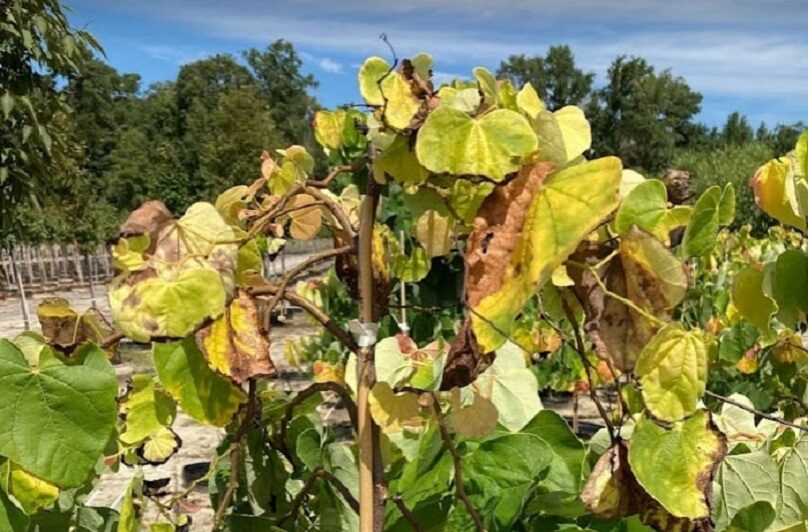
Any Fairfax County residents who recently bought a budding tree or shrub may want to keep an eye on its leaves.
A relatively new disease called vascular streak dieback is killing plants from nurseries in Virginia and five other states, the Department of Public Works and Environmental Services’ (DPWES) Urban Forest Management Division says.
“Dieback may look like yellowing or paling of the leaves’ green color (leaf chlorosis), brown or scorched leaf margins and stunting and/or wilting of current year’s growth,” DPWES said in a press release on Tuesday (Oct. 3).
In Virginia, the plants that appear to be most susceptible to the disease are maple, dogwood and redbud trees, according to Virginia Tech and the Virginia Cooperative Extension (VEC), which have cataloged 21 different affected woody ornamental plant species, as of March.
First detected in cacao in Papua New Guinea during the 1960s, vascular streak dieback was mostly confined to southeast Asia until the past couple of years. The Virginia Department of Agriculture and Consumer Services (VDACS) confirmed that the disease had emerged in the state last year.
Researchers have traced the disease to a fungus called Ceratobasidium theobromae, whose spores get carried from plant to plant by the wind, according to DPWES.
“After a spore infects a leaf, it travels into the branch and the main stem’s woody tissue, eventually killing the plant,” the department says. “Researchers continue to study VSD, and the fungus related to it, to find ways to prevent infection and the potential spread into the natural environment.”
Available data on how to prevent VSD is limited, but Virginia Tech and the VEC say it can help to minimize stress on plants by ensuring they have the right amount of soil, water and other conditions needed to stay healthy.
Here’s more from DPWES:
Virgina Cooperative Extension recommends that nurseries ensure best management practices of plant stock to prevent chances of infection. Residents looking for trees in nurseries may consider asking nursery staff about vascular streak dieback and if the internal woody tissue may safely be checked for VSD before purchasing. Also, look for any signs of scorched leaves and buds or dieback of young stems. If VSD is suspected in a recent purchase report it to the Virginia Cooperative Extension and dispose of the plant material correctly to prevent its potential spread. Plants, or the suspected live branches, also may be bagged and either taken or mailed to the Extension, where the disease can be positively identified. If mailing, a two-day delivery is best to avoid damage to live tissue.
The county’s urban forest management team has also been combatting a beech leaf disease that emerged in the area last fall and the invasive spotted lanternfly, which feeds on trees, shrubs and herbs “in unusually large numbers,” DPWES has said.

Virginia is beginning to create plans for how to reduce greenhouse gas emissions, the primary driver of climate change, on a state and regional basis thanks to millions of dollars from the federal government.
This June, the U.S. Environmental Protection Agency awarded about $6 million in grants to Virginia’s Department of Environmental Quality, regional planning organizations in Northern Virginia, Richmond and Hampton Roads and the Monacan Indian Nation to create two plans.
One, the Priority Climate Action Plan, will identify projects that can immediately start reducing greenhouse gas emissions. The other, the Comprehensive Climate Action Plan, aims to craft long-term strategies to achieve reductions.
“This grant will help us plan for reducing climate pollution and promoting climate resilience in the commonwealth, both of which are central to our mission,” said DEQ Director Mike Rolband at a webinar last week. “Just as changing climatic conditions impact all of Virginia, these changes also impact all of the environmental programs here at DEQ. “
The funding for the Climate Pollution Reduction Grants program comes from the Inflation Reduction Act, major federal legislation passed last year that aims to spur investments in climate technologies.
The priority plan is due in March 2024. Projects included in the plan will be eligible to compete for an additional $4.6 billion round of grants for implementation.
The comprehensive plan is due later, in July 2025, and will involve broader strategies for reducing emissions from the transportation, electricity and other sectors, as well as an analysis of the benefits of greenhouse gas reductions.
Both plans require that officials consider the benefits of reductions for low-income and disadvantaged communities and monitor emissions.
Statewide plan
Virginia’s Department of Environmental Quality will be the lead agency coordinating the state’s planning process, which will include the Virginia Department of Transportation, Department of Housing and Community Development, Department of Conservation and Recreation and other agencies.
Virginia has already taken a number of significant steps to reduce greenhouse gas emissions, many of which DEQ cited in its application to the EPA.
The 2020 Virginia Clean Economy Act seeks to decarbonize the state’s electric grid by 2050 by setting renewables development targets for regulated utilities and mandating that increasing portions of their generation be carbon-free. In 2021, Virginia also tied its vehicle emissions standards to California’s rather than remaining on the federal standard in an effort to drive greater adoption of electric vehicles, and the state is planning to use National Electric Vehicle Infrastructure program funds for charging infrastructure buildouts.
Additionally, Virginia since 2021 has participated in the regional carbon market known as the Regional Greenhouse Gas Initiative, or RGGI. That program requires electricity producers to pay for allowances for each ton of carbon they emit and returns the revenues to the state for energy efficiency and flood preparedness programs. Read More
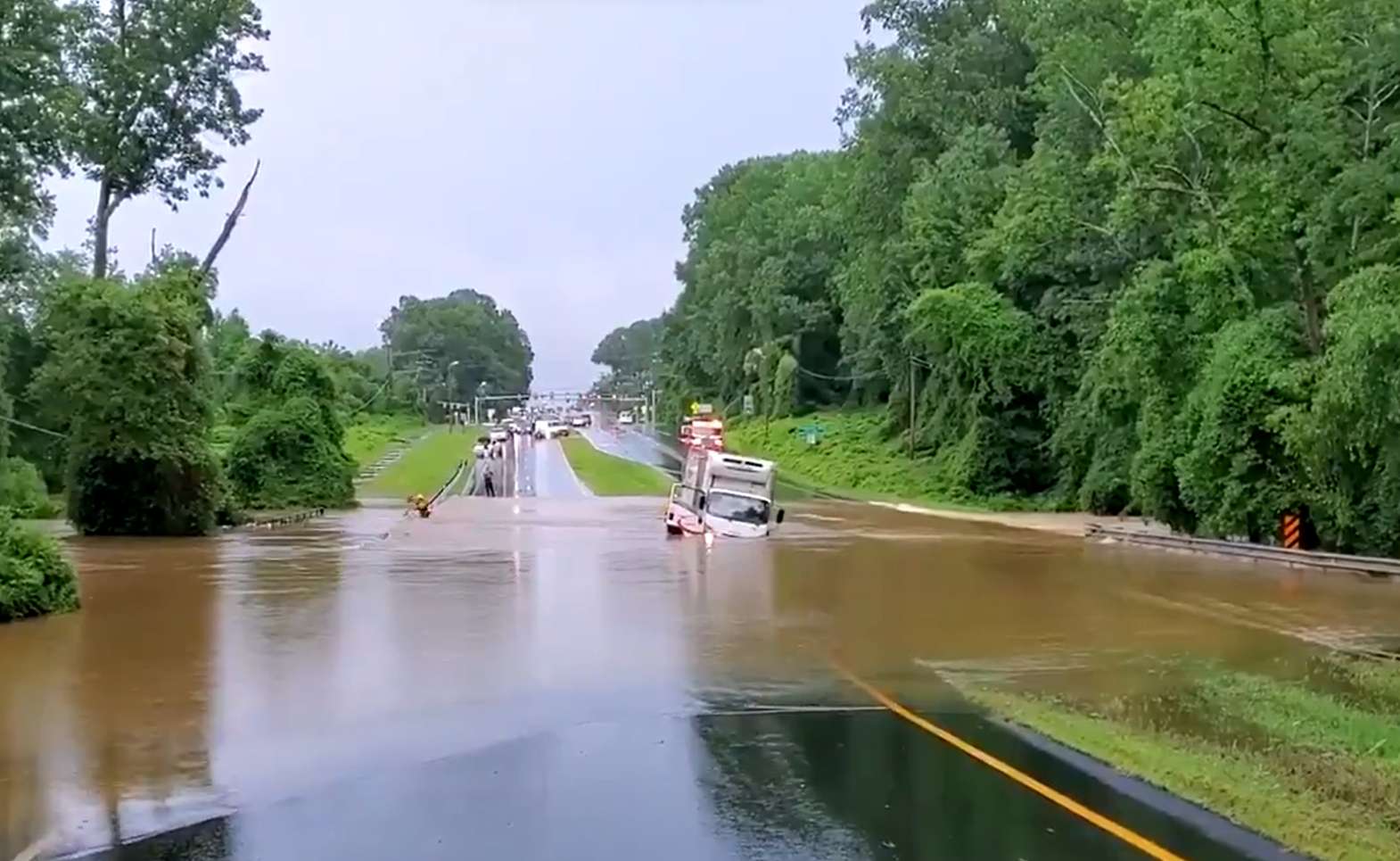
The Fairfax County Department of Public Works and Environmental Services (DPWES) has proposed a new grant program to help curb flooding in the county.
The flood mitigation assistance program (FMAP) would reimburse residents and property owners for purchasing and installing approved products and services that reduce the risk of flood damage to their property.
The program calls for a cost-sharing agreement where the resident or property owners cover 50% of the cost, and the county covers the other half up to $5,000, DPWES Deputy Director Eleanor Ku Codding told the Fairfax County Board of Supervisors at an environmental committee meeting on Tuesday (Oct. 3).
The program was made to be flexible, according to Codding. It’s open to residential or commercial multi-family properties, common-interest communities, and places of worship. Approved flood mitigation practices include:
- window wells
- flood gates
- modified basement areaways
- sump pump backup batteries
- utility protection
- exterior grading or drains
However, if an owner wanted to use another flood mitigation service not listed, it would be considered on a case-by-case basis.
Codding said, since drainage is not a straightforward issue, sharing the cost is a good solution.
“By establishing a cost-share program, we are allowing residents to be empowered to take action to mitigate that risk of flooding,” she said. “In addition, we have seen that the best flood risk reduction programs — including FEMA — include these types of cost-share programs.”
Dranesville District Supervisor John Foust supported the program but called for the county to take more action.
“We should be thinking bigger in terms of stormwater management because it’s a huge problem,” Foust said. “And once we adopt this, then we’ll be done with it. We’ll check it off and move on to the next thing, and I just think the problem deserves more.”
Codding said other programs could be brought to the board in the future.
The county has discussed raising its building stormwater standards to accommodate more frequent and extreme flooding, and earlier this year, it piloted a program for sharing the cost of projects with private property owners, essentially testing the approach proposed for the new assistance program.
Funded through the county’s Stormwater Service District taxes, FMAP would start on July 1, 2024, and applications would be reviewed on a first come, first served basis. The Northern Virginia Soil and Water Conservation District would administer the program.
DPWES will return to the board at a public hearing to get authorization to sign the memorandum of understanding with the conservation district. The agreement will establish rules for how the district should administer the program.
Screenshot via FCFRD/Twitter
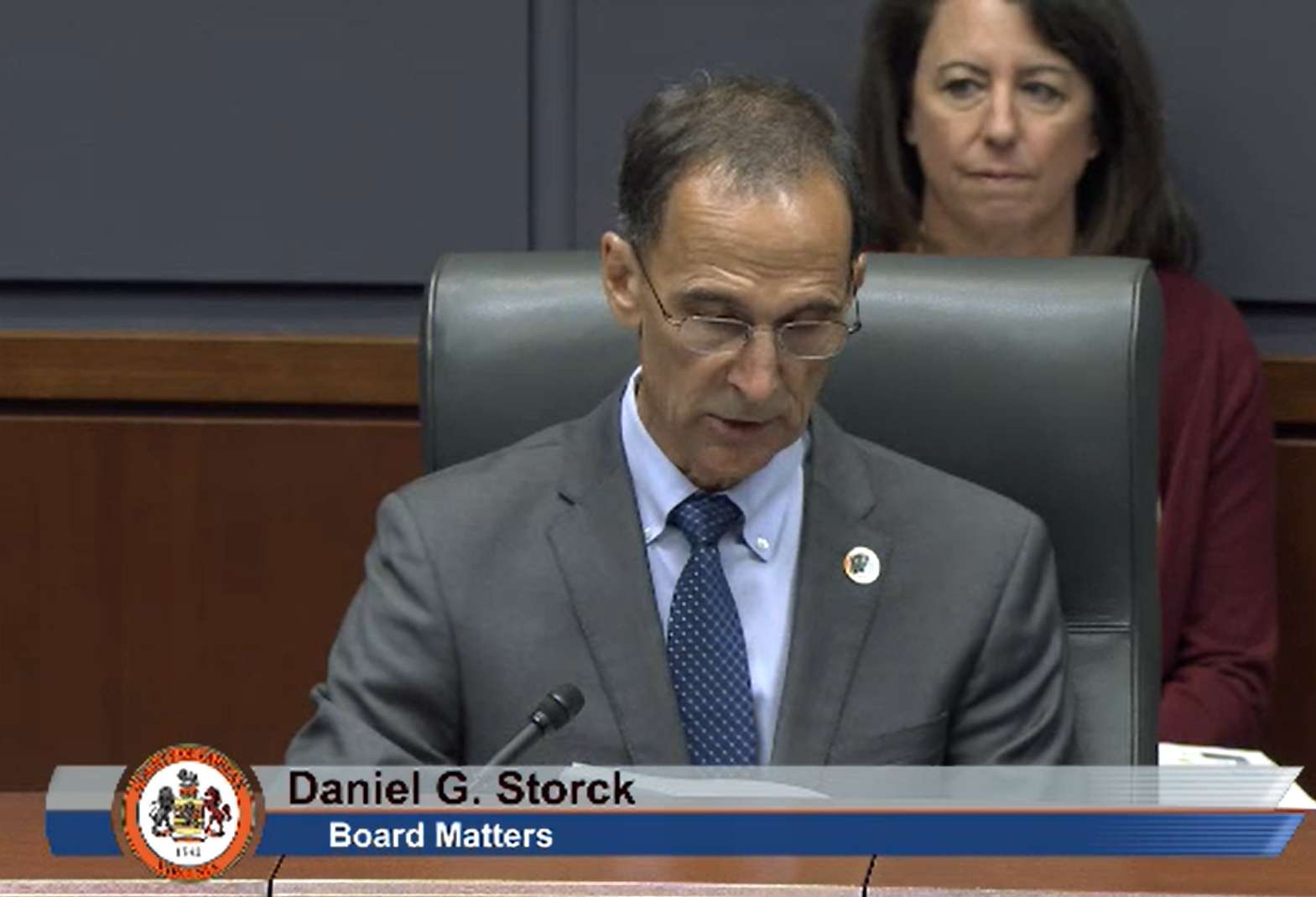
A senior at Langley High School, a county planner who helped craft an environmental plan for Reston, and a local business dedicated to reducing waste are among the recipients of this year’s Fairfax County Environmental Excellence Awards.
Handed out annually since 2000, the awards recognize residents, county staff, businesses and other organizations “who demonstrate extraordinary leadership within the community and exceptional dedication to the preservation and enhancement of the county’s natural resources,” according to the Office of Environmental and Energy Coordination.
Announced at the Fairfax County Board of Supervisors meeting on Tuesday (Sept. 12), the winners were selected by the Environmental Quality Advisory Council, an advisory group appointed by the board. The council administers the awards with OEEC’s support.
“By giving their time, passion and expertise for the betterment of our environment, these awardees are true climate champions,” said Mount Vernon District Supervisor Dan Storck, who chairs the board’s Environmental Committee. “We applaud them for leading by example and helping to ensure that our county residents and visitors can enjoy a healthy and beautiful Fairfax County for decades to come.”
The lone winner in the individual county resident category was Mei Torrey, a rising senior at Langley High School who “promotes and actively seeks opportunities to increase awareness of, and take action on, local sustainability issues,” the OEEC says.
Now president of her school’s Saxons Go Green environmental club, Torrey has organized fundraisers and worked with the nonprofit Clean Fairfax to design and distribute reusable bags to local retailers and low-income communities, according to the county.
The 2023 award lineup features three winners in the “county employee” category:
Hugh Whitehead, an Urban Forester with the Urban Forest Management Division. In 2016, Mr. Whitehead initiated a tree planting program in partnership with Fairfax County Public Schools. Since 2016, a total of 494 trees have been planted at twenty-one different K through 12 schools including seven Title 1 schools. This program not only supports the Board’s Sustainability Initiatives, reforestation goals, and recommendations from the Joint Environmental Task Force, but furthers educational opportunities throughout the county.
Joe Gorney, a Planner with the Department of Planning and Development, Environment and Development Review Branch. Mr. Gorney works collaboratively with other county agencies on a diverse range of environmental review topics, working to create a sustainable future for residents and employees. He was the staff lead for the Environmental Plan guidance update for the Reston planning study, designating Reston as “biophilic” community.
Craig Carinci, Director of Department of Public Works and Environmental Services, Stormwater Planning Division. Mr. Carinci provides excellence in leadership through monitoring and improving stream health. During his tenure as Director, Fairfax County has restored over 100,000 linear feet of streams, facilitated by his open-minded leadership and business acumen that fearlessly encourages his team to push forward on initiatives and collaborate with partners to achieve cost savings.
The Environmental Excellence Awards for organizations and businesses went to Trace the Zero Waste Store, which can be found at 140 Church Street NW in Vienna, and the grounds committee of the Montebello Condominium Unit Owners Association. Read More
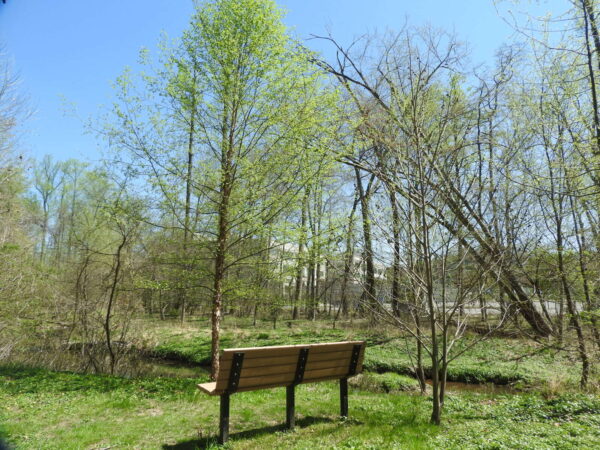
In an effort to reverse a decrease in the tree canopy, Vienna’s government is taking another step towards tree preservation and plantings. Last week, the town council discussed proposed amendments to enhance tree canopy, including moving forward with a tree conservation ordinance and the possible creation of an independent tree commission.
Town Attorney Steven Brigalia said the tree conservation ordinance would put the town in line with Fairfax County, which has had conservation rules since 1990. He said it would require builders to indicate which trees can and cannot be saved before cutting them.
“They are still allowed to develop their property,” Brigalia said. “But they have to upfront identify the trees and give justification if they’re going to take out trees, and then they still have to meet a canopy requirement.”
Under the town’s current canopy requirements, developers are only required to replace eliminated trees to meet canopy standards. Also, for single-family residential lots, builders must provide enough trees to cover at least 20% of the lot after 20 years. A conservation ordinance would increase that 20-year standard to 25%.
Brigalia said the town would have to provide provisions if they increase the standard to 25%. For example, if a developer says they are unable to preserve a 25% canopy, they would pay into a tree bank or tree fund.
There’s also a requirement for allowing additional credits for the developer if they provide certain types of trees.
Brigalia also hopes to strengthen the town’s tree board.
“There’s not a lot of authority for what they can do except advise the town on good tree planning processes and advise the town on planning on public property,” he said, adding that the board could eventually give recommendations of where to plant trees with money from the tree fund.
Councilmember Howard Springsteen said he hadn’t heard of the tree board in his 14 years of service.
“I never heard of it, so I rather have a tree commission that reports to council,” he said.
Springsteen also said residents are starting to voice concern about the town’s tree coverage, prompting the need for the council to act according to council member Ray Brill.
“We need to set up something separate, that focuses on tree canopy if, in fact, we believe it’s an issue. I personally believe it’s an issue, and we need to focus on it and get it done and get it done,” Brill said.
The council voted to refer the proposed ordinance to the planning commission for their consideration and review. A public hearing on the ordinance is scheduled for Oct. 23.
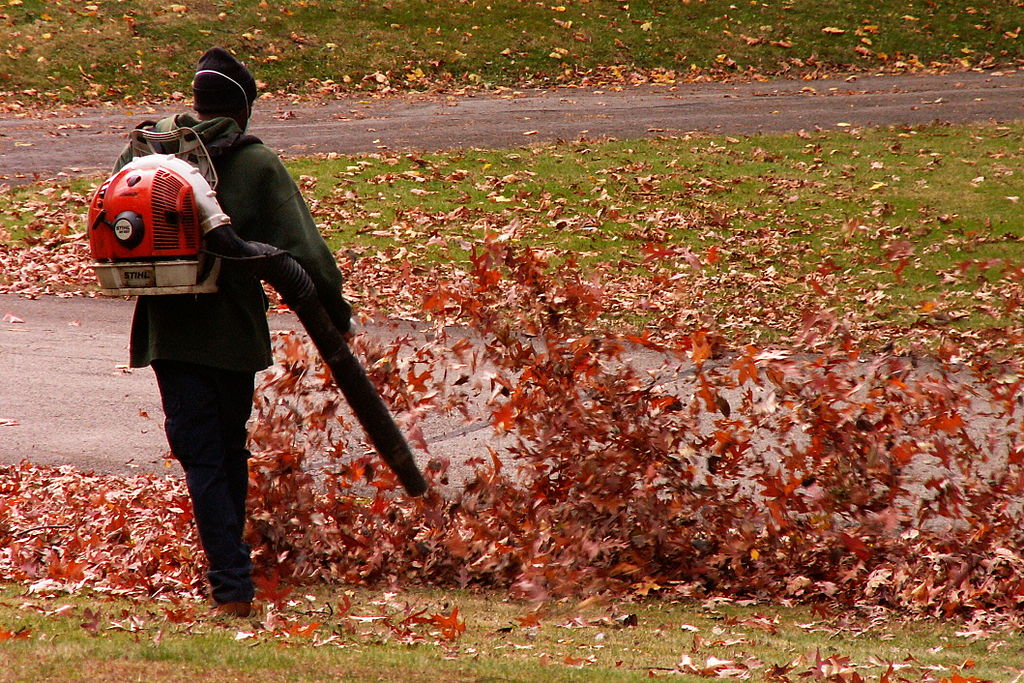
Fairfax County is steadily making progress on efforts to cut its use of gas-powered leaf blowers.
By the end of June next year — the conclusion of the 2024 fiscal year — the county plans to ensure that the supply of electric blowers and string trimmers is nearly 50% electric, according to John Silcox, a spokesperson for the Fairfax County Office of Environmental and Energy Coordination.
That means that 105 of the 217 leaf blowers owned and operated by the county will be powered by electric batteries.
“As funding allows, agencies will continue to replace aging gas models with new electric equipment,” Silcox said.
The effort is part of a countywide initiative to shift toward eco-friendly practices that reduce the county government’s carbon footprint overall.
In the fiscal year 2024 budget, for example, the county will replace 55 gas-powered leaf blowers with electric ones.
The county says transitioning to electric-powered lawn equipment will help reduce carbon emissions, noise and costs.
“Even as Fairfax County’s facilities are making the switch to battery-powered blowers and other electric equipment, we encourage residents and contractors to do the same,” Silcox said.
The effort has been underway since at least November 2021.
Photo via Cbaile19/Wikimedia Commons
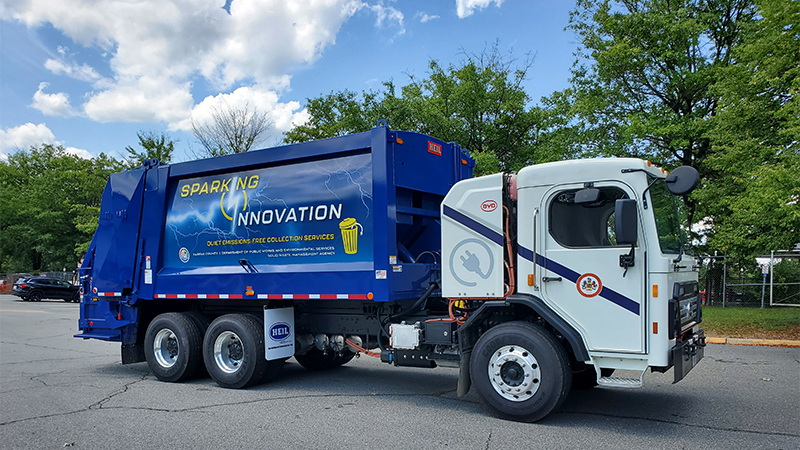
The Fairfax County Department of Public Works and Environmental Services (DPWES) is unveiling its first electric refuse trash truck today (Friday).
The truck will “pick up residential trash and yard waste on routes throughout the county,” DPWES announced. The county says the truck is “a move that will save money and protect the environment.”
The unveiling falls in line with the county’s strategy to make government operations carbon-neutral by 2040.
“Electric vehicles produce zero emissions, meaning cleaner air for Fairfax County. Electric vehicles are quieter, also reducing noise pollution. The electric truck saves residents money by requiring less overall maintenance and eliminating fuel costs,” the site reads.
The truck will join a fleet that already has 50 electric vehicles in operation, including four sedans used by DPWES. In addition, Fairfax County Public Schools has eight electric school buses.
Scott Peterson, vice chair of local environmental advocacy group Faith Alliance for Climate Solutions, called the new trash truck a positive first step.
“We hope the trial is successful and that electric trash trucks in the county, both private and county-owned, will quickly become the new normal,” Peterson said. “Heavy trucks running through our neighborhoods won’t be polluting the air we all breathe, and they’ll be so much quieter, too.”
Charging stations have been installed at the DPWES Newington Collections facility at 6901 Allen Park Road, where the county is holding the unveiling.
“When the battery has less than 20 percent of power, it will take up to five hours to recharge. Once it’s on its route, this truck can hold up to seven tons of recycling and up to 12 tons of trash,” the county says.
The trucks cost the county roughly $350,000 and are paid for by the Department’s Solid Waste Management Program and a Virginia Department of Environmental Quality grant. The county expects to have a second electric truck in September.
The unveiling is open to the public, and several county lawmakers are scheduled to speak. The event starts at 11 am.
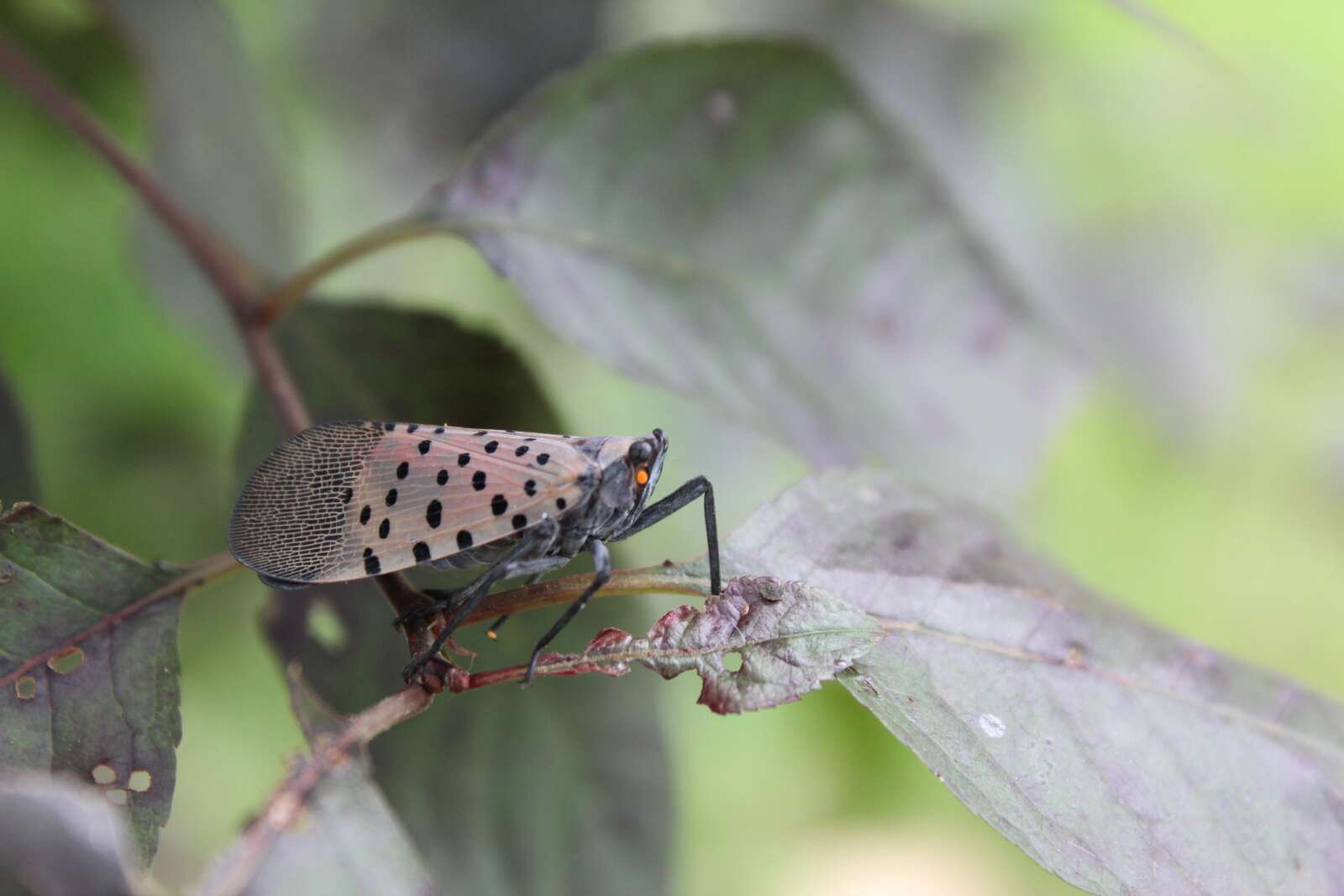
More reports of the spotted lanternfly are popping up throughout Fairfax County, according to local officials.
The invasive insect — which is native to China, India and Vietman — has been seen in more areas of the county, the Fairfax County Department of Public Works and Environmental Services says.
Officials are asking the public to help kill the pest. So far, the Maryland Department of Agriculture has been working closely with the county to determine how to reduce its numbers.
After first arriving in a grocery store shipment to Annandale, the bugs have primarily proliferated in the western area of the county, including Herndon, Centreville and Chantilly. Infestations have also been reported in Burke and Dunn Loring, according to a DPWES graphic.
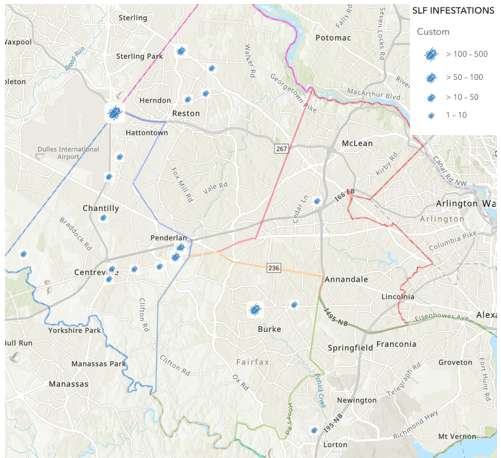
The insects feasts on more than 70 plant species, particularly the invasive tree-of-heaven, and is particularly problematic for Virginia, where they’re threatening the peach, apple, grape and wine industries, DPWES says.
“Spotted lanternfly has the potential to cause severe nuisance to residents by feeding on trees, shrubs and herbaceous plants in unusually large numbers and leaving a sticky, smelly mess when they leave,” DPWES said. “While plant mortality is not a widespread concern, the nuisance created by these insects could cause some reactionary behaviors, leading to unnecessary pesticide use and the potential removal of valuable tree canopy and other vegetation.”
Egg masses are common in September and throughout the first few hard frosts. Vehicles help spread the pest around, particularly those near trees or the edges of a forest.
Here’s more from DPWES on how to help:
If you find spotted lanternfly, please report your findings through the mobile app iNaturalist or call 703-324-5304.
You can also report your findings by email at ReportSLF@fairfaxcounty.gov. Provide photos and an address with your report.
After careful identification, trap or kill the insect, and scrape and smash the egg mass.
Check your vehicles, trailers and mobile equipment (tractors, bobcats, etc.) before visiting other locations.
Photo via Magi Kern/Unsplash
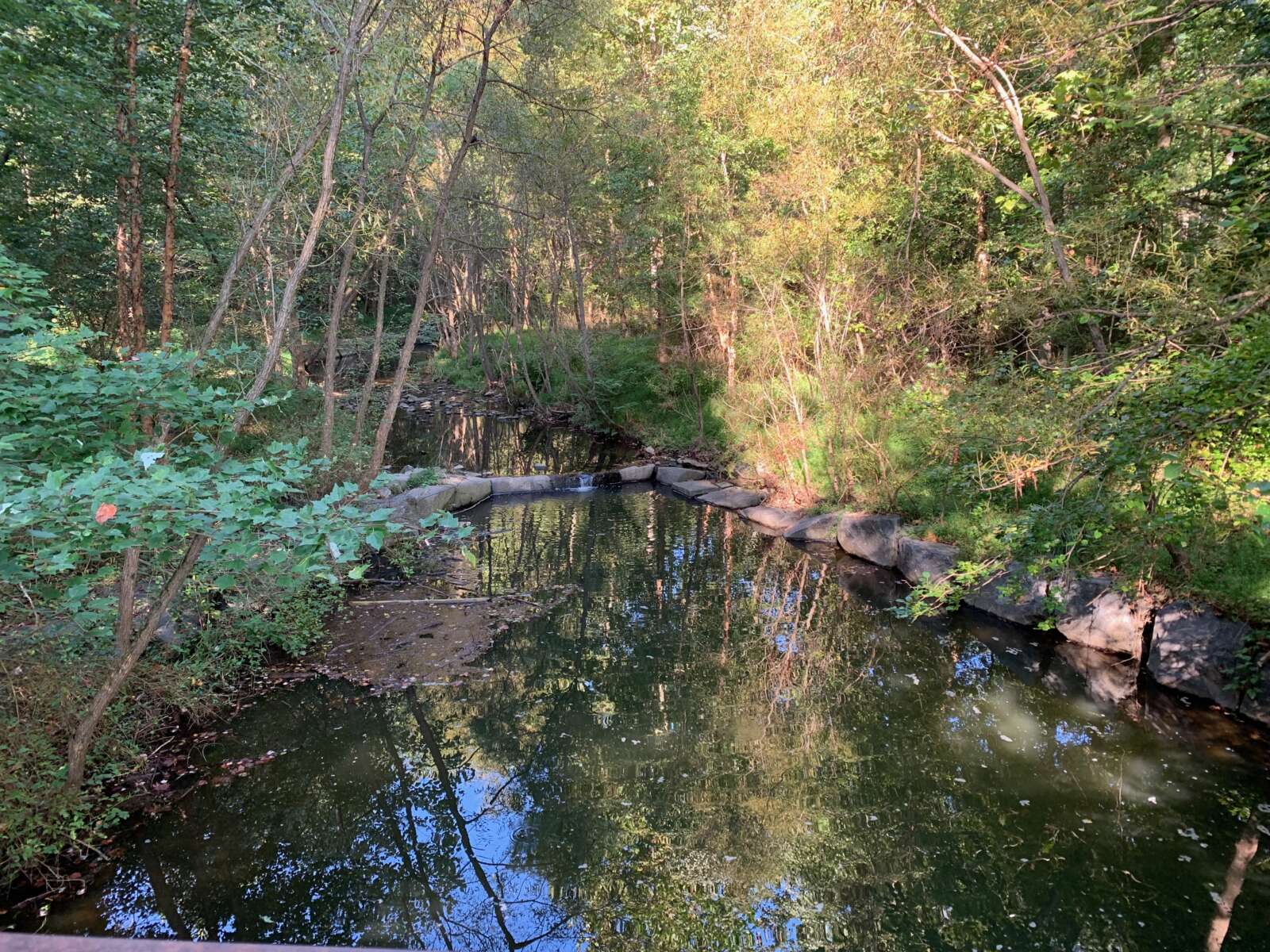
Updated at 5:45 p.m. — The fish deaths reported at Snakeden Branch stream this morning have been traced to a water main break behind Hunters Woods Plaza, Reston Association says.
“Potable water was discharged and included chlorine, causing the fish kill,” RA Chief Operating Officer Peter Lusk said. “The water main break has been repaired, and the stream is considered safe, and not harmful to humans or animals.”
Earlier: Dead fish were found earlier this morning (Friday) at Snakeden Branch stream, according to a report confirmed by Reston Association.
A foul smell also protruded from the stream.
RA staff are working with the Virginia Department of Environment Quality (DEQ) and the Fairfax County Stormwater Planning Division to confirm the cause of the incident.
Residents are encouraged to avoid using the stream. Signage has been posted at the stream, which flows from Hunters Woods Village Center to Lake Audubon.
RA is also urging residents to be cautious when using Lake Audubon until the source of the issue is confirmed.
Preliminarily, there is no evidence that the issue was caused by sewage, according to RA COO Peter Lusk.
“These events typically occur when there are malfunctions within wastewater systems, water mains, or occasionally illicit dumping. RA staff will confirm the source of the issue, once identified,” RA said.

Several environmental groups, including one based in Fairfax County, have joined forces to challenge Gov. Glenn Youngkin’s decision to pull Virginia out of a cross-state initiative aimed at reducing carbon emissions.
The Southern Environmental Law Center announced on Monday (July 31) that it will appeal Virginia’s planned withdrawal from the Regional Greenhouse Gas Initiative (RGGI), a market of 12 states on the East Coast that regulates carbon emissions from power generators.
The appeal will be filed in Fairfax County Circuit Court on behalf of Appalachian Voices, the Association of Energy Conservation Professionals, Virginia Interfaith Power and Light and the Faith Alliance for Climate Solutions (FACS), a Fairfax County-focused coalition of religious communities pushing for action to address climate change.
The notice of appeal was served on the same day that the proposal to drop out of the RGGI was published in the Virginia Register, opening a period of public comments until the regulation takes effect on Aug. 30.
“The Regional Greenhouse Gas Initiative…has cut a huge amount of pollution from power plants, while protecting Virginians from the increasing impacts of climate change,” FACS Executive Director Andrea McGimsey said. “RGGI helps us leave a better world to our children and grandchildren, and we will continue to vigorously defend Virginia’s participation in this successful, bipartisan program.”
Established in 2005, the RGGI imposes a cap on carbon emissions from power plants in all participating states, requiring generators to buy “allowances” at quarterly auctions for every short ton of carbon they produce.
On Jan. 1, 2021, Virginia became the first southern state to join the initiative under then-governor Ralph Northam, who also signed legislation mandating an end to the use of coal-fired power plants after 2024 and requiring Dominion Energy to go carbon-free by 2045.
However, Youngkin issued an executive order on Jan. 15, 2022 calling for a reevaluation of Virginia’s participation and signaling his plans to withdraw. He argued that utilities have passed on the costs of purchasing allowances to customers, noting that residents served by Dominion Energy saw an average increase in their electricity bills of $2.39 per month.
Dominion suspended the surcharge after Youngkin announced his withdrawal plan, but last month, the State Corporation Commission approved its return. The fee of $4.44 for a “standard” customer will take effect on Sept. 1, even though the State Air Pollution Control Board voted 4-3 on June 7 to take Virginia out of the RGGI.
“RGGI remains a regressive tax which does not do anything to incentivize the reduction of emissions in Virginia,” Virginia Secretary of Natural and Historic Resources Travis Voyles said in a statement shared by Youngkin’s office. “…Virginians will see a lower energy bill in due time because we are withdrawing from RGGI through a regulatory process.”
Environmental advocates dispute the assertion that the RGGI hasn’t resulted in any benefits. In fact, Virginia saw an over 16% drop in power plant emissions after two years in the initiative based on Environmental Protection Agency data, according to FACS Vice Chair Scott Peterson.
The state also devotes half of its proceeds from the allowance auctions — totaling $250 million over the first two years — to energy efficiency programs for affordable housing and low-income households. Other funds have been used to support resiliency projects, most of them focused on reducing flooding impacts.
“There is a huge need for this funding not just in coastal areas, but also inland communities that are dealing with increasingly frequent intense storms,” Peterson said. “Almost $100 million has already been awarded to 98 different projects, but this work is long term and only getting started.”
The groups challenging the RGGI withdrawal argue that Youngkin’s administration lacks the authority to reverse a law adopted by the General Assembly. Their appeal must be filed in court within 30 days of the notice going to Air Pollution Control Board and Department of Environmental Quality officials.
“The administration cannot brush aside the laws it disagrees with,” Southern Environmental Law Center senior attorney Nate Benfornado said. “Moreover, Virginians deserve to see the continued benefits of this successful program. This program is vital to Virginia meeting climate goals, while reducing air pollution and improving public health.”
Voyles said Attorney General Jason Miyares’s office confirmed that the control board “has the legal authority to take action on the regulatory proposal using the full regulatory process — and the Board voted to do just that.”
Pending the legal action, Virginia will leave the RGGI when its three-year contract ends Dec. 31.
Photo via Ella Ivanescu/Unsplash

